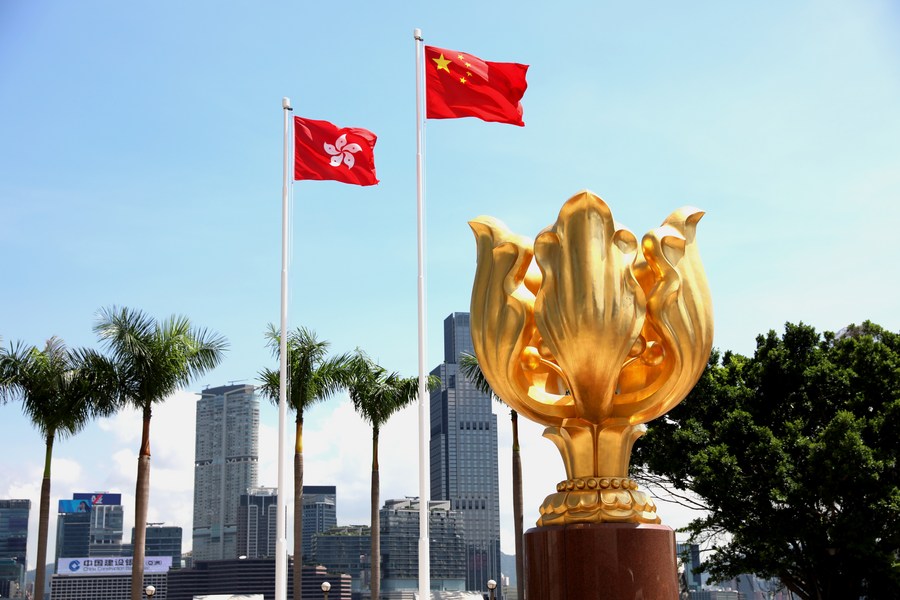SAR's entry into RCEP to bring big opportunities


The accession of the Hong Kong Special Administrative Region to the Regional Comprehensive Economic Partnership - one of the world's largest free trade pacts - would create opportunities not only for the city, but also for other members of the grouping, says Chief Executive John Lee Ka-chiu.
Hong Kong can add value to the pact through its business-friendly environment, a sound financial system and a low tax regime, he said in a speech at the 5th China International Import Expo and the Hongqiao International Economic Forum held in Shanghai last month.
"Hong Kong is one of the world's most externally oriented and open economies. We thrive on trade and spare no effort in consolidating our status as an international trading center, a position affirmed by our country's national 14th Five-Year Plan (2021-25)," he said.
"As the world's largest free trade agreement, the Regional Comprehensive Economic Partnership is an exciting opportunity that Hong Kong very much looks forward to. That's why I said in my (maiden) Policy Address we're actively pursuing early accession to the RCEP."
Joining the RCEP would strengthen Hong Kong's business ties with all RCEP member economies, Lee said, reaffirming the SAR's strong and unwavering commitment to free and open trade against the headwinds of unilateralism.
He also revealed recently that all the 10 member states of the Association of Southeast Asian Nations have pledged their support for Hong Kong's accession to the RCEP. Discussions are due to begin next year - nearly 10 months after the SAR said it intended to join the pact.
Hong Kong's accession to the RCEP would indeed be great news for the SAR and the Chinese mainland as it would reinforce their stance on multilateralism and an international free trade framework. As one of the world's key financial and trading centers, a global city and the gateway to the Guangdong-Hong Kong-Macao Greater Bay Area, as well as the rest of China, the SAR can provide essential project financing and professional services support, innovation and technology. It also has the capacity to be a hub for Chinese State-owned enterprises to team up with other RCEP members in financing joint investments and opportunities in countries and regions involved in the Belt and Road Initiative.
The RCEP - one of the world's largest free trade deals in history - was signed on Nov 15, 2020, after eight years of negotiations. Currently, it comprises 15 Asia-Pacific economies, including all 10 ASEAN member states. The pact accounts for 32 percent of the global economy, and 44 percent of the world's population, reaching 3.5 billion consumers.
It's estimated the deal would raise national incomes by $186 billion annually by 2030 and add 0.2 percent to the economies of the group's members. It aims to progressively lower tariffs, reduce protectionism and boost investment. Furthermore, it will allow for one set of rules of origin to qualify for tariff reductions with other RCEP members (a common set of regulations means less procedures and easier movement of goods). Once ratified by all parties, the RCEP would be the world's largest free trade agreement in terms of members' GDP.
The RCEP includes chapters covering trade in goods, trade in services, investment, economic and technical cooperation, and creates new rules for electronic commerce, intellectual property, government procurement, competition, and small and medium-sized enterprises.
Apart from the economic size of the deal, it marks the first time China, Japan and South Korea are part of a single free trade agreement, and also the first time China has joined a nonbilateral free trade agreement of such a scale.
From China's perspective, the RCEP aligns with the nation's "dual circulation" vision, refocusing on domestic demand, while taking advantage of trade and foreign investment. It must also be noted that ASEAN has become China's largest trading partner followed by the EU and the United States.
The RCEP marks a big victory for China, allowing it to extend its influence in the region. Although negotiations on forming the RCEP began in 2012 - well before former US president Donald Trump took office in 2017 - it's undeniable that Trump's protectionist policies hastened the agreement. Trump pulled the United States out of the Trans-Pacific Partnership shortly after becoming president and launched a counterproductive trade war with China in 2018, which not only affected both countries' economies, but also those of many other nations tightly integrated into the global value chain.
Premier Li Keqiang has described the RCEP as a "victory for multilateralism and free trade". The timing of the pact couldn't have been better. As the nation's 14th Five-Year Plan (2021-2025) emphasizes that China will participate in multilateral and bilateral regional investment and trade cooperation mechanisms, the RCEP is consistent with this goal.
The RCEP marks a firm step forward in supporting economic recovery in Asia, creating jobs and strengthening regional supply chains.
Although, at its formation, the RCEP included China, but not the HKSAR, Hong Kong must apply for membership separately. The nation's support for fast-tracking Hong Kong's accession to the RCEP was given at the 7th Belt and Road Summit held in Hong Kong in early September, showcasing the central government's continued and unreserved assistance for the city.
The author is a fintech adviser, researcher and a former business analyst for a Hong Kong publicly listed company.
The views do not necessarily reflect those of China Daily.
- Former senior official of Ningxia sentenced to death
- Development program narrows urban-rural gap in Guangdong
- Wuxi Winter Bazaar creates cross-cultural gathering
- Expressway service area featuring a natural hot spring to open soon in Guangdong
- Former Ningxia political advisor sentenced to death for bribery
- Former senior official of Jiangxi expelled from CPC





































